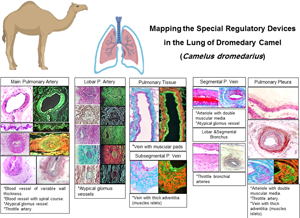No CrossRef data available.
Published online by Cambridge University Press: 23 March 2022

Dromedary camel (Camelus dromedarius) is adapted to survive the harsh environments. It has some key adaptation peculiarities in various organs. In this study, we aimed to map the distribution pattern of unique regulatory devices along the course of the pulmonary vessels using histological and histochemical analyses. Arteries with variable wall thickness and spirally oriented course were recorded within the adventitia of the main pulmonary artery. Throttle arteries and glomus bolsters were found within the wall of the lobar pulmonary artery. The bronchial artery was located within the wall of all bronchi reaching the subsegmental branches and it had elastic longitudinal muscular intima bolsters. Arteries with double muscular media were demonstrated in the pulmonary pleura. These bolsters are suggested to play a complicated role that allows for hemodynamic, humeral, and thermoregulatory activities. The lumen of some subsegmental pulmonary veins revealed occasional constrictions arising from the corresponding muscular pad-like protrusions of the tunica media. These veins may possess occlusive or constrictive mechanisms and their obstruction induces engorgement of the associated capillary bed in addition to restricting venous outflow. Collectively, these data strongly recommend a crucial role for the special regulatory devices in preserving the camel pulmonary function in the harsh desert environment.
Current address: Department of Developmental Biology, Graduate School of Integrated Science for Life, Hiroshima University, Higashi-Hiroshima 739-8526, Japan.